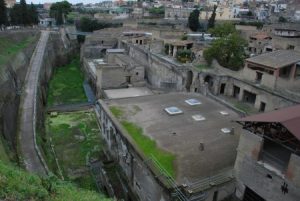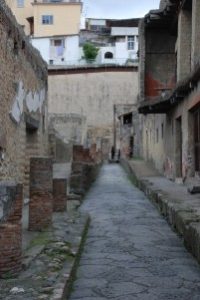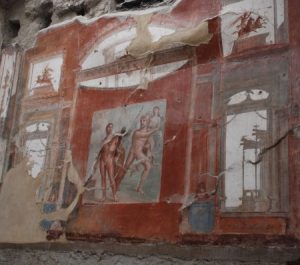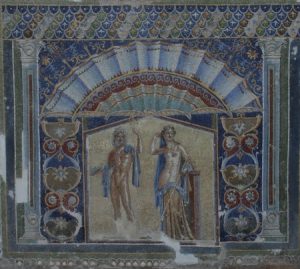
The Herculaneum ruins (outside Naples, Italy) showcase 1st century Roman life. Mount Vesuvius’ powerful volcanic eruptions destroyed this robust seaside city. In 79 C.E., Herculaneum along with nearby Pompeii were consumed by up to 20 meters of volcanic material. The liquid eventually hardened and encased the city.
Future archeologists look at the composition of this volcanic material as a mixed blessing. Despite the challenging excavation process, the original structures were surprisingly well preserved. None of the buildings in Herculaneum collapsed during Vesuvius’ eruption.
Since its discovery in the 18th century, archeologists have been working to uncover the ancient Roman seaside town and its remaining artifacts and skeletons. To date, only a third of the city’s known territory has been excavated. While Herculaneum may be smaller and less famous than Pompeii, the Herculaneum structures are more intact and easier to visualize. Just about everything in Pompeii succumbed to the pressure of the falling volcanic material and tremors.

Even though most of Herculaneum has yet to be excavated, visitors will see the major elements of an ancient Roman town. One can walk down narrow streets that have remnants of structures and also see the aqueduct system that supplied the city’s water.

Like other Roman antiquity sites, Herculaneum had an arena and numerous bathhouses. Herculaneum is set apart from other excavated Roman sites due to its well-preserved and visible accouterments of wealth—decorative mosaics, elaborately decorated wall frescoes, marble accessories and intricately carved statues.

Roman artwork is located throughout the site.
Also be on the look out for the blackened scrolls that were found in the Villa of the Papyri. The eruption’s excessive heat carbonized almost everything it touched. Scientists estimate that the surge in Herculaneum reached temperatures up to 400 degrees Celsius.
Due to its location and name recognition, more visitors find their way to Pompeii. As a result, Herculaneum is ideal for people looking for smaller crowds and a more compact site.
Before You Go
Visitors should also check out the possibility of taking a hike to Mount Vesuvius’ crater, touring nearby Pompeii, or visiting the National Archaeological Museum in Naples.
Remember to bring a hat, sturdy shoes, sunglasses, ample water, and a camera.
ON MARCH 8, 2016, THE ABOVE ARTICLE WAS ORIGINALLY PUBLISHED ON EXAMINER.COM. IT IS BEING REPOSTED ON THIS SITE BECAUSE THE EXAMINER SITE SHUT DOWN IN JULY, 2016. SOME PARTS OF THE ORIGINAL ARTICLE HAVE BEEN UPDATED AND THE ORIGINAL SLIDE SHOW HAS BEEN ELIMINATED.
RELATED BLOGS
Pompeii: An Example of Volcanic Destruction
Explore Vesuvius National Park: Europe’ Active Volcano Site
Kotor, Montenegro—a land and sea adventure
Dubrovnik—a walkable coastal town
Madeira—a year round destination
Castelo de S. Jorge: historical Lisbon castle with stunning views
Teide National Park—a lunar like adventure
BIO
Sandra Bornstein is a freelance travel writer. She shares her travel experiences and recommendations on this blog and on other websites—One Travel: Going Places, Cheapoair.com Miles Away Travel Blog, We Said Go Travel, Mom It Forward, Boulder Jewish News, and Family Circle.
Sandra is the author of MAY THIS BE THE BEST YEAR OF YOUR LIFE. This memoir highlights Sandra’s living and teaching adventure in Bangalore, India. She is a licensed Colorado teacher who has taught K-12 students in the United States and abroad as well as college level courses.
The memoir was a finalist in the Travel category for the 2013 Next Generation Indie Book Awards, the 2013 International Book Awards, the 2013 National Indie Book Excellence Awards, 2013 USA Best Book Awards, and a Honorable Mention award in the Multicultural Non-Fiction category for the 2013 Global ebook Awards.
Leave a Reply
You must be logged in to post a comment.